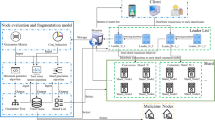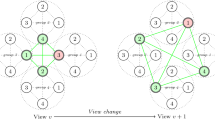Abstract
The consortium blockchain has three challenges in terms of performance, security, and privacy when adopting the Practical Byzantine Fault Tolerance (PBFT) protocol. The throughput and scalability of consortium blockchain are focused on meanwhile the privacy protection can hardly be ignored. This work proposes a privacy-preserving multi-signature and hierarchical Byzantine consensus protocol. Specifically, the signature combines a ring signature and a Schnorr one to provide three levels of privacy protection. The consensus protocol layers the network nodes into different clusters, which overcomes the shortcomings of PBFT and Schnorr signature. The theoretical analysis proves the security and privacy of the protocol and expounds the application scenarios, and the efficiency evaluation shows that the signature verification speed is 6.28 times faster than the Schnorr scheme, and the consensus in a 250-nodes network is 51.3% faster than the Schnorr-based PBFT consensus.







Similar content being viewed by others
References
Nakamoto S (2008) Bitcoin: A peer-to-peer electronic cash system. https://bitcoin.org/bitcoin.pdf
Wood G et al (2014) Ethereum: A secure decentralised generalised transaction ledger. Ethereum Project Yellow Paper 151:1–32
Clark J, Edward A, Felten W (2015) Research perspectives and challenges for bitcoin and cryptocurrencies. https://eprint.iacr.org/2015/261.pdf
Conti M, Kumar ES, Lal C, Ruj S (2018) A survey on security and privacy issues of bitcoin. IEEE Communications Surveys & Tutorials 20(4):3416–3452
Zamani M, Movahedi M, Raykova M (2018) Rapidchain: Scaling blockchain via full sharding. Proceedings of the 2018 ACM SIGSAC Conference on Computer and Communications Security pp 931–948
Kokoris-Kogias E, Jovanovic P, Gasser L, Gailly N, Syta E, Ford B (2018) Omniledger: A secure, scale-out, decentralized ledger via sharding. 2018 IEEE Symposium on Security and Privacy (SP) pp 583–598
Gilad Y, Hemo R, Micali S, Vlachos G, Zeldovich N (2017) Algorand: Scaling byzantine agreements for cryptocurrencies. Proceedings of the 26th Symposium on Operating Systems Principles pp 51–68
Feng X, Ma J, Miao Y, Meng Q, Liu X, Jiang Q, Li H (2019) Pruneable sharding-based blockchain protocol. Peer-to-Peer Netwo Appl 12(4):934–950
Castro M, Liskov B et al (1999) Practical byzantine fault tolerance. OSDI 99:173–186
Kogias EK, Jovanovic P, Gailly N, Khoffi I, Gasser L, Ford B (2016) Enhancing bitcoin security and performance with strong consistency via collective signing. 25th \(\{\)usenix\(\}\) security symposium (\(\{\)usenix\(\}\) security 16) pp 279–296
Androulaki E, Barger A, Bortnikov V, Cachin C, Christidis K, De Caro A, Enyeart D, Ferris C, Laventman G, Manevich Y, et al. (2018) Hyperledger fabric: a distributed operating system for permissioned blockchains. Proceedings of the thirteenth EuroSys conference pp 1–15
Bessani A, Sousa J, Alchieri EE (2014) State machine replication for the masses with bft-smart. 2014 44th Annual IEEE/IFIP International Conference on Dependable Systems and Networks pp 355–362
Sousa J, Bessani A (2012) From byzantine consensus to bft state machine replication: A latency-optimal transformation. 2012 Ninth European Dependable Computing Conference pp 37–48
Ristenpart T, Yilek S (2007) The power of proofs-of-possession: Securing multiparty signatures against rogue-key attacks. Annual International Conference on the Theory and Applications of Cryptographic Techniques pp 228–245
Li CM, Hwang T, Lee NY (1994) Threshold-multisignature schemes where suspected forgery implies traceability of adversarial shareholders. Workshop on the Theory and Application of of Cryptographic Techniques pp 194–204
Harn L (1994) Group-oriented (t, n) threshold digital signature scheme and digital multisignature. IEE Proceedings-Computers and Digital Techniques 141(5):307–313
Horster P, Michels M, Petersen H (1995) Meta-multisignature schemes based on the discrete logarithm problem. Information Security the Next Decade pp 128–142
Rivest RL, Shamir A, Tauman Y (2001) How to leak a secret. International Conference on the Theory and Application of Cryptology and Information Security pp 552–565
Blum M, Feldman P, Micali S (1988) Non-interactive zero-knowledge and its applications. Proceedings of the twentieth annual ACM symposium on Theory of computing pp 103–112
Wu H, Wang F (2014) A survey of noninteractive zero knowledge proof system and its applications. Sci World J
Schnorr CP (1991) Efficient signature generation by smart cards. J Cryptol 4(3):161–174
Maxwell G, Poelstra A, Seurin Y, Wuille P (2018) Simple schnorr multi-signatures with applications to bitcoin. Des Codes Crypt 87(9):2139–2164
Kwon J (2014) Tendermint: Consensus without mining. https://tendermint.com/static/docs/tendermint.pdf
Li P, Wang G, Chen X, Long F, Xu W (2020) Gosig: a scalable and high-performance byzantine consensus for consortium blockchains. Proceedings of the 11th ACM Symposium on Cloud Computing pp 223–237
Johnson D, Menezes A, Vanstone S (2001) The elliptic curve digital signature algorithm (ecdsa). Int J Inf Secur 1(1):36–63
Li Y, Qiao L, Lv Z (2021) An optimized byzantine fault tolerance algorithm for consortium blockchain. Peer-to-Peer Networking and Applications pp 1–14
Bresson E, Stern J, Szydlo M (2002) Threshold ring signatures and applications to ad-hoc groups. Annual International Cryptology Conference pp 465–480
Chow SS, Hui LC, Yiu SM (2004) Identity based threshold ring signature. International Conference on Information Security and Cryptology pp 218–232
Herranz J, Sáez G (2004) Distributed ring signatures for identity-based scenarios. IACR Cryptol ePrint Arch
Boneh D, Gentry C, Lynn B, Shacham H (2003) Aggregate and verifiably encrypted signatures from bilinear maps. International Conference on the Theory and Applications of Cryptographic Techniques pp 416–432
Boneh D, Lynn B, Shacham H (2001) Short signatures from the weil pairing. International conference on the theory and application of cryptology and information security pp 514–532
Drijvers M, Edalatnejad K, Ford B, Kiltz E, Loss J, Neven G, Stepanovs I (2019) On the security of two-round multi-signatures. 2019 IEEE Symposium on Security and Privacy (SP) pp 1084–1101
Damgård I, Orlandi C, Takahashi A, Tibouchi M (2021) Two-round n-out-of-n and multi-signatures and trapdoor commitment from lattices. IACR International Conference on Public-Key Cryptography pp 99–130
Goodell B, Noether S (2018) Thring signatures and their applications to spender-ambiguous digital currencies. IACR Cryptol ePrint Arch
Leiba O, Yitzchak Y, Bitton R, Nadler A, Shabtai A (2018) Incentivized delivery network of iot software updates based on trustless proof-of-distribution. 2018 IEEE European Symposium on Security and Privacy Workshops (EuroS&PW) pp 29–39
Badr MM, Al Amiri W, Fouda MM, Mahmoud MM, Aljohani AJ, Alasmary W (2020) Smart parking system with privacy preservation and reputation management using blockchain. IEEE Access 8:150823–150843
Nick J, Ruffing T, Seurin Y, Wuille P (2020) Musig-dn: Schnorr multi-signatures with verifiably deterministic nonces. Proceedings of the 2020 ACM SIGSAC Conference on Computer and Communications Security pp 1717–1731
Nick J, Ruffing T, Seurin Y (2021) Musig2: Simple two-round schnorr multi-signatures. Annual International Cryptology Conference pp 189–221
Acknowledgements
This work was supported in part by Open project of Sichuan Provincial Key Laboratory of Intelligent Terminal Co built by Province and City (SCITLAB-1014), and in part by Sichuan Science and Technology Program (2021YFG0305).
Author information
Authors and Affiliations
Corresponding authors
Ethics declarations
Competing interests
The authors have no competing interests to declare that are relevant to the content of this article.
Additional information
Publisher’s Note
Springer Nature remains neutral with regard to jurisdictional claims in published maps and institutional affiliations.
Rights and permissions
About this article
Cite this article
Wu, X., Ling, H., Liu, H. et al. A privacy-preserving and efficient byzantine consensus through multi-signature with ring. Peer-to-Peer Netw. Appl. 15, 1669–1684 (2022). https://doi.org/10.1007/s12083-022-01317-4
Received:
Accepted:
Published:
Issue Date:
DOI: https://doi.org/10.1007/s12083-022-01317-4




